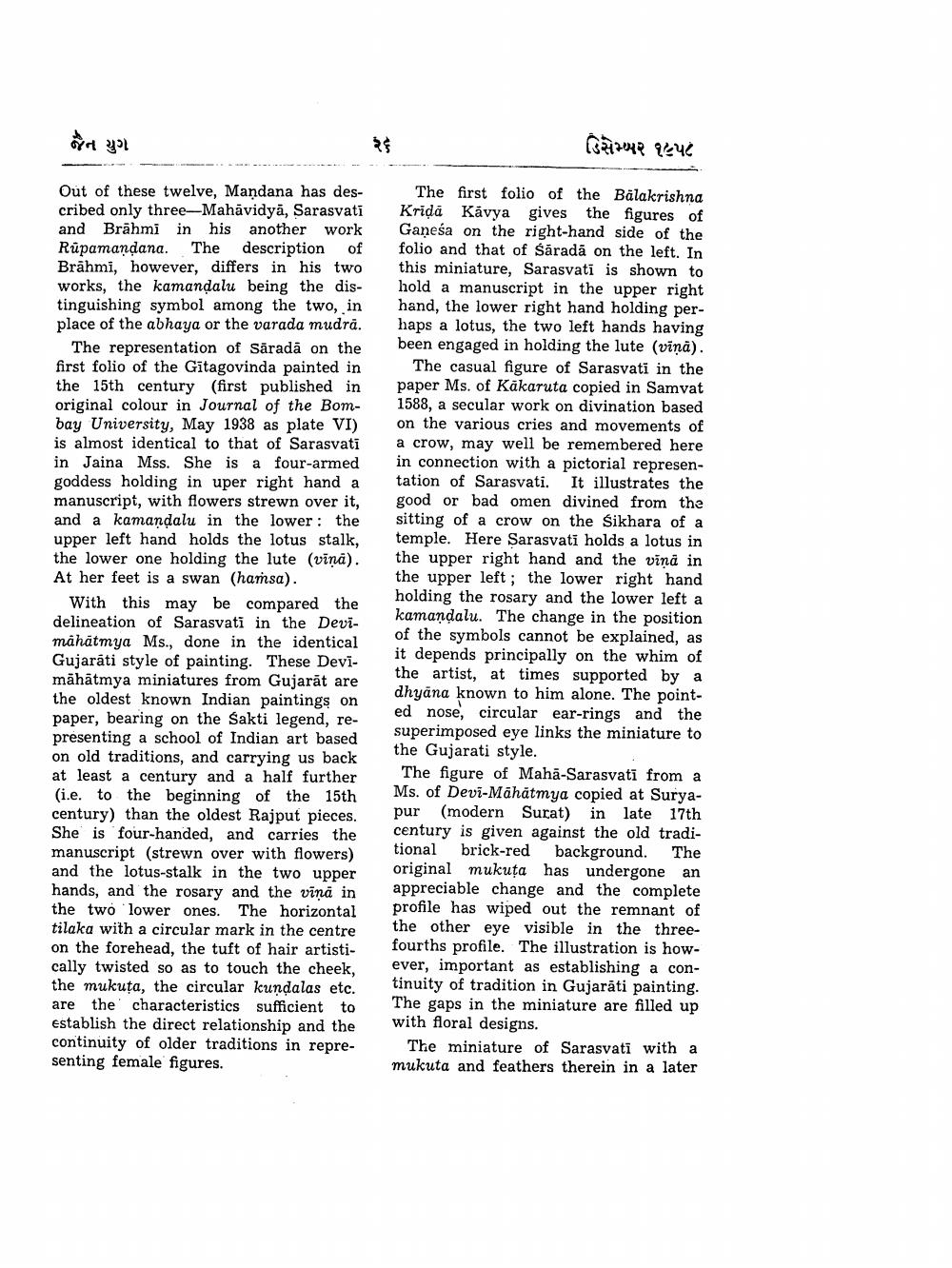________________
જેન યુગ
ડિસેમ્બર ૧૯૫૮
Out of these twelve, Mandana has described only three-Mahavidyā, Sarasvati and Brāhmi in his another work Rüpamandana. The description of Brāhmi, however, differs in his two works, the kamandalu being the distinguishing symbol among the two, in place of the abhaya or the varada mudra.
The representation of Sāradā on the first folio of the Gitagovinda painted in the 15th century (first published in original colour in Journal of the Bombay University, May 1938 as plate VI) is almost identical to that of Sarasvati in Jaina Mss. She is a four-armed goddess holding in uper right hand a manuscript, with flowers strewn over it, and a kamandalu in the lower : the upper left hand holds the lotus stalk, the lower one holding the lute (viņa). At her feet is a swan (hamsa).
With this may be compared the delineation of Sarasvati in the Devimahatmya Ms., done in the identical Gujarati style of painting. These Devimāhātmya miniatures from Gujarāt are the oldest known Indian paintings on paper, bearing on the Sakti legend, representing a school of Indian art based on old traditions, and carrying us back at least a century and a half further (i.e. to the beginning of the 15th century) than the oldest Rajput pieces. She is four-handed, and carries the manuscript (strewn over with flowers) and the lotus-stalk in the two upper hands, and the rosary and the viņa in the two lower ones. The horizontal tilaka with a circular mark in the centre on the forehead, the tuft of hair artistically twisted so as to touch the cheek, the mukuta, the circular kundalas etc. are the characteristics sufficient to establish the direct relationship and the continuity of older traditions in representing female figures.
The first folio of the Balakrishna Krida Kavya gives the figures of Ganesa on the right-hand side of the folio and that of Săradā on the left. In this miniature, Sarasvati is shown to hold a manuscript in the upper right hand, the lower right hand holding perhaps a lotus, the two left hands having been engaged in holding the lute (vina).
The casual figure of Sarasvati in the paper Ms. of Käkaruta copied in Samvat 1588, a secular work on divination based on the various cries and movements of a crow, may well be remembered here in connection with a pictorial representation of Sarasvati. It illustrates the good or bad omen divined from the sitting of a crow on the Sikhara of a temple. Here Sarasvati holds a lotus in the upper right hand and the vina in the upper left; the lower right hand holding the rosary and the lower left a kamandalu. The change in the position of the symbols cannot be explained, as it depends principally on the whim of the artist, at times supported by a dhyāna known to him alone. The pointed nose, circular ear-rings and the superimposed eye links the miniature to the Gujarati style.
The figure of Maha-Sarasvati from a Ms. of Devi-Māhātmya copied at Suryapur (modern Surat) in late 17th century is given against the old traditional brick-red background. The original mukuta has undergone an appreciable change and the complete profile has wiped out the remnant of the other eye visible in the threefourths profile. The illustration is however, important as establishing a continuity of tradition in Gujarati painting. The gaps in the miniature are filled up with floral designs.
The miniature of Sarasvati with a mukuta and feathers therein in a later




